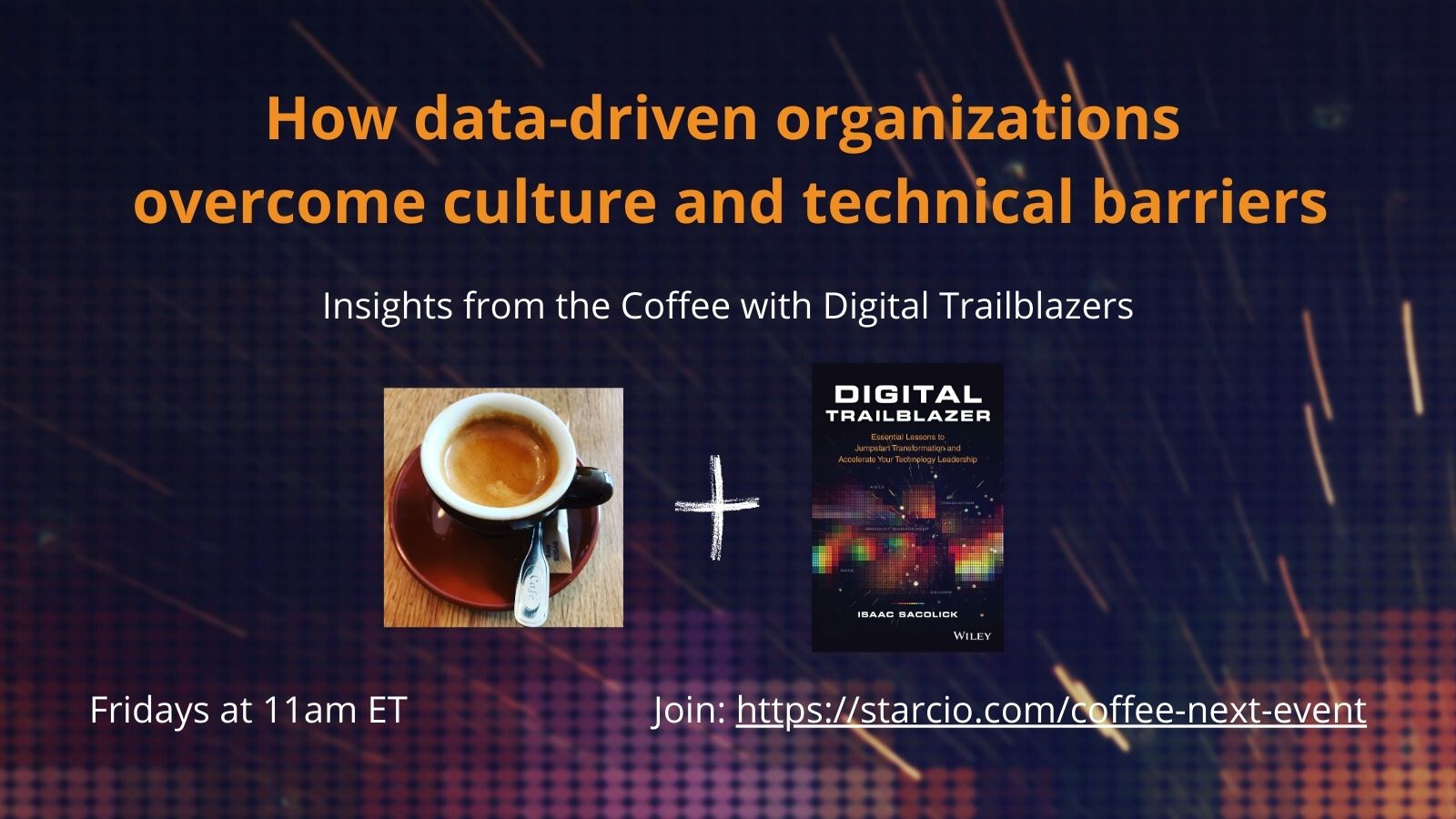Experienced technology and data leaders shared their experiences establishing data-driven organizations during a recent Coffee with Digital Trailblazers episode. I host the event Fridays at 11 am ET, and while we’ve discussed many leadership topics tied to digital transformation over the weeks, this was our first episode where we focused on data practices.
Citizen data practices, proactive data governance, and delivering value from
machine learning are key themes in my writing and speaking. I wrote about my
experiences of being buried in bad data in
Digital Trailblazer and shared many of
my best practices in Driving Digital.
My recent posts include
how to expand citizen data science from successful analysts to
data-driven organizations
and on
eradicating “IT Business Alignment” by empowering a data-driven
partnership. Data-driven organizational practices are a major focus area for
StarCIO’s Center of Excellence
programs.
So, I was anxious to hear how they would respond to my questions:
- What is your definition of a data-driven organization? What does it look like? What aspects are truly “critical”?
- People-first approaches: What cultural barriers did you overcome and how?
- Tech debt, data debt, security, governance: How can leaders unpack all the barriers and deliver value faster?
5 key insights for CIOs, chief data officers, and data leaders
Our discussions tend to bounce around people, process, and technology
concepts during the coffee hour. It makes for a fast and interesting
discussion, but capturing the key takeaways isn’t easy. This episode was
filled with insights, and here are key recommendations from the group on
what data-driven organizations do well:
Focus on value – Start with the end in mind and review the business
value first and use these goals as a guide to trace back to relevant data
sources. Once at the sources, you can then perform a more diligent review
around data quality, processing issues, data governance gaps, and data
management issues through a prioritized lens of what’s required to deliver
accurate and timely business outcomes.
Get the language right – There’s enough data jargon and technologies
to make a business leader’s head spin. Avoid asking them to assume the role
of the data owner and define data quality KPIs; instead, get into the weeds
by reviewing facts, data definitions, and actionable metrics. You can’t jump
into insights without reviewing the data, and business leaders can best
understand data quality issues when examples illustrate them.
Develop disciplined data scientists – Leaders advised many of the
best practices: (1) Draft a
vision statement
before building anything, (2) Apply
agile data practices, and (3) Document and share the data lineage, calculations, and machine
learning models, used in any dashboards, analytics, and models.
Build trust by maturing data practices – They treat data as a
corporate asset, implying that data must deliver value but requires ongoing
investment. They focus on “democratizing data” by making the data easy to
work with for everyone in the organization. “I shouldn’t need to consult
with a subject matter expert to access or understand the data.” They also
recognize that a handful of internal data products (dashboards, models,
etc.) are far more useful than maintaining hundreds of customized
reports.

Key data practices for Digital Trailblazers
After the coffee hour, I followed up with Joanne Friedman, PhD., CEO, and
principal of smart manufacturing at Connektedminds, to detail some of her
insights. “In digital transformation or industry 4.0, the flexibility of
data choreography means we can optimize the value of the data by placing it
in different contexts,” she says.
Data choreography was a new term for me, so I asked Joanne to share its definition and relate it to data lineage and data provenance. Here’s her reply:
- Data provenance is data’s historical record keeper and is responsible for providing a list of origins, including inputs, entities, systems, and processes related to specific data.
- Data lineage provides an in-depth description of where data comes from, including its analytic life cycle.
- Data choreography is a design pattern used in software engineering where each component or service interacts with other components or services through an exchange of messages.
These definitions made me think of recipes in a cookbook: (i) Data
provenance is the ingredients, where they’re sourced, and their overall
quality, (ii) data lineage is the steps to follow in the recipe, and (iii)
data choreography speaks to how easy and repeatable the recipe is in
creating the dish.
The ability to focus on value, adopt data-driven practices, and use
storytelling to influence decision-makers is the choreography required for
data-driven organizations to deliver transformative results.
I hope you’ll join us for future episodes of
Coffee with Digital Trailblazers!

No comments:
Post a Comment
Comments on this blog are moderated and we do not accept comments that have links to other websites.